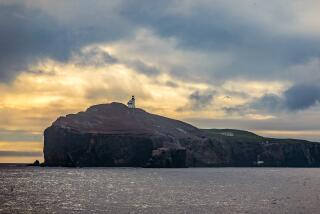Once Upon A Time, : There Was a Little Girl Stranded on a Channel Island.
- Share via
In the year 1960, a novelist named Scott O’Dell gave literary birth to Karana, an Indian girl alone on a wild Southern California island. The world received her happily, and the historically based “Island of the Blue Dolphins” joined the standard canon of children’s literature. Now, however, as her 30th birthday is celebrated and a special edition of the book reaches bookstore shelves, at least one renegade historian is mulling the possibility that Karana has never been the character that millions of faithful readers--and O’Dell himself--thought she was . . .
Several authorities agree that the historical model for Karana was not a 12-year-old girl grieving over a dead brother, but a mature mother who outlived her young son. And according to one controversial theory, the original Karana--whom readers know as an otter-loving native of the Channel Islands--is seen as a displaced Aleutian, marooned on an otter-hunting expedition. What would Scott O’Dell say?
“I think he would be fascinated,” said Matilda Welter, the Houghton Mifflin senior editor who handled O’Dell’s work from 1979 until his death last year.
“Island of the Blue Dolphins,” O’Dell’s first effort at writing for children, is the story of a native girl’s struggles alone on the wild island--65 miles south-southwest of Point Mugu--for 18 years. In the book, Karana contends with wild dogs that kill her younger brother, avoids otter-hunting Indians from the Aleutian Islands, attains a spiritual peace with the natural world around her, and ultimately comes ashore with a priest from the Santa Barbara Mission.
“It held me spellbound from the first word,” wrote Rachel Carson in the New York Times.
“Years of research must have gone into this book, to turn historical fact into so moving and lasting an experience,” wrote another reviewer for The Hornbook magazine.
In 1964, Universal Pictures made the story a movie, filming on the coast about 150 miles north of San Francisco, using Indians of the Manchester and Kashia tribes as extras and casting Celia Kaye, a part-Cherokee girl from Pasadena, in the central role.
O’Dell, a journalist-turned-author who grew up in Southern California, had written five historical novels with no great success. He wrote “Island of the Blue Dolphins,” he said, as a reaction against the cruelty of hunters near his San Diego County residence in Julian. For research on the woman he named Karana, O’Dell consulted the Southwest Museum in Los Angeles and the San Diego Museum of Man.
“She’s an appealing character, even to boys, apparently,” said Welter. “Children are always fascinated by stories of survival, going back to Robinson Crusoe. The idea of the survivor is one of the most compelling images in children’s literature.”
O’Dell, Welter added, “talked often about his interest in writing about young women and their relationship to society--particularly young women of independence and self-sufficiency. He was an early feminist, I guess.”
Research records that O’Dell left with his publisher indicate that he might have known of the lone woman’s possible motherhood, but that he probably never imagined Karana as an Indian from the Northwest.
In any event, Welter said, “he had a tendency to transform history, rather than follow it in any slavish way.”
After the book’s success, O’Dell went on to become one of the most-admired authors of children’s literature in this century. He wrote two dozen more books in the genre--including “Zia,” a sequel that describes Karana’s final days on the mainland.
His death--in October, 1989, at age 91--came just as the stirrings of Karana’s new life were being heard.
On the East Coast, Houghton Mifflin, the original publisher of “Island of the Blue Dolphins,” was assembling a new, illustrated anniversary edition of the book--a treatment traditionally accorded to classics in the genre. Before his death, O’Dell chose artist Ted Lewin to illustrate the book. The finished product, priced at $18.95 and accompanied by 12 watercolor illustrations, was released in October.
On the West Coast, meanwhile, Santa Barbara anthropologist and historian Marla Daily was chasing down a new hypothesis on San Nicolas history. Under that theory, the original lone woman was not an island native at all, but a marooned member of an otter-hunting tribe from Alaska or the Aleutian Islands.
When Daily first presented those ideas in a research paper at a history symposium, she said: “People were angry that I even would suggest such a thing, because they had grown up with this myth. . . . They didn’t want their bubble burst, and I had somehow threatened this wonderful cute story that everyone knew.”
Word of that response didn’t surprise Welter.
“Children take what they read as gospel,” she said. “And because the book has been so popular, it sticks in their mind. If something comes along to undermine something they learned in their childhood, they resist it. In a way, it’s a tribute to the book’s popularity.”
Other critics, including John Johnson, curator of anthropology at the Santa Barbara Museum of Natural History, dispute Daily’s ideas more quietly.
“Marla has an interesting theory,” Johnson said, “but I don’t agree with it.”
The generally accepted information surrounding the lone woman of San Nicolas Island is slim: She is thought to have been a San Nicolas native, abandoned when settlers evacuated all the Indians they could find from the island in 1836. She was discovered and removed, without dissent, to the Santa Barbara Mission in 1853. She died later that year, and her cormorant feather coat was eventually forwarded by church officials to Rome.
She was described as middle-aged and good-looking. Although the woman spoke with apparent fluency, mission officials were unable to find anyone, Indian or otherwise, who recognized her language. On her deathbed at the Santa Barbara Mission, she was baptized Juana Maria, and her body was buried on the mission grounds.
Authorities say most of that information survives from an 1880 account in Scribner’s Monthly, written by Santa Barbara historian Emma Hardacre after interviews with many of those involved with the woman’s discovery.
But Hardacre also kept a private notebook, and a 1986 re-reading of that journal led Daily to the alternative theory she published last year in California History magazine.
“There is a doubt in my own mind whether the woman was Indian,” Hardacre had written in the undated notebook. “There is a rumor that a very short time before the island was depopulated, a woman was cast ashore from a wreck, and that shortly after she gave birth to a child. This information has reached me since the material was gathering for my article as originally published.”
In the note, Hardacre points out that the lone woman’s manner, upon rescue, “was not that of a creature utterly unfamiliar with house conveniences--her tact in meeting strangers, receiving their gifts politely, and after they were gone--distributing them among children of her host.”
Beyond Hardacre’s rumor and suspicions, Daily has marshaled further provocative facts:
At least three firsthand 19th-Century accounts described ships from the Northwest hunting otter near San Nicolas island, and each noted that the ships brought Indians from Sitka, Alaska, the Aleutian Islands or elsewhere in what was then “Russian America.” Numerous accounts say the Northwestern hunters killed many of the less aggressive island natives.
Padre Senan of the Mission San Buenaventura wrote in 1816 that four “Russian Indians” were among converts recently arrived from the Channel Islands.
The wild dogs reported on San Nicolas Island by the lone woman’s discoverers may have been of Alaskan breed.
More conservative authorities reply by citing studies of Southern California Indian language that suggest the lone woman spoke Gabrieleno, a language also found on other southern Channel Islands. They also note that no direct ties between the woman and the Northwest have been established. So far, several historians agreed, no one has made a watertight case for the lone woman’s lineage, northern or southern.
“That’s the question,” said Richard A. Pierce, history professor at the University of Alaska, Fairbanks, and a follower of 19th-Century Russian trade on the West Coast. “And that is still unanswered.”
“I don’t know,” said Charles Johnson, librarian for the Ventura County Historical Society. Daily, he said, “does pose some interesting questions.”
Meanwhile, as the research and theorizing continues, the anniversary edition of “Island of the Blue Dolphins” is said to be showing strong pre-Christmas sales--another generation of readers for the idealized Karana.
“No matter what, it’s a very romantic notion,” said Jody Fickes, owner of the Adventures for Kids bookshop in Ventura.
“It’s fascinating to think that there’s another possibility. Boy, that makes for another whole book you could write.”
More to Read
Sign up for our Book Club newsletter
Get the latest news, events and more from the Los Angeles Times Book Club, and help us get L.A. reading and talking.
You may occasionally receive promotional content from the Los Angeles Times.











